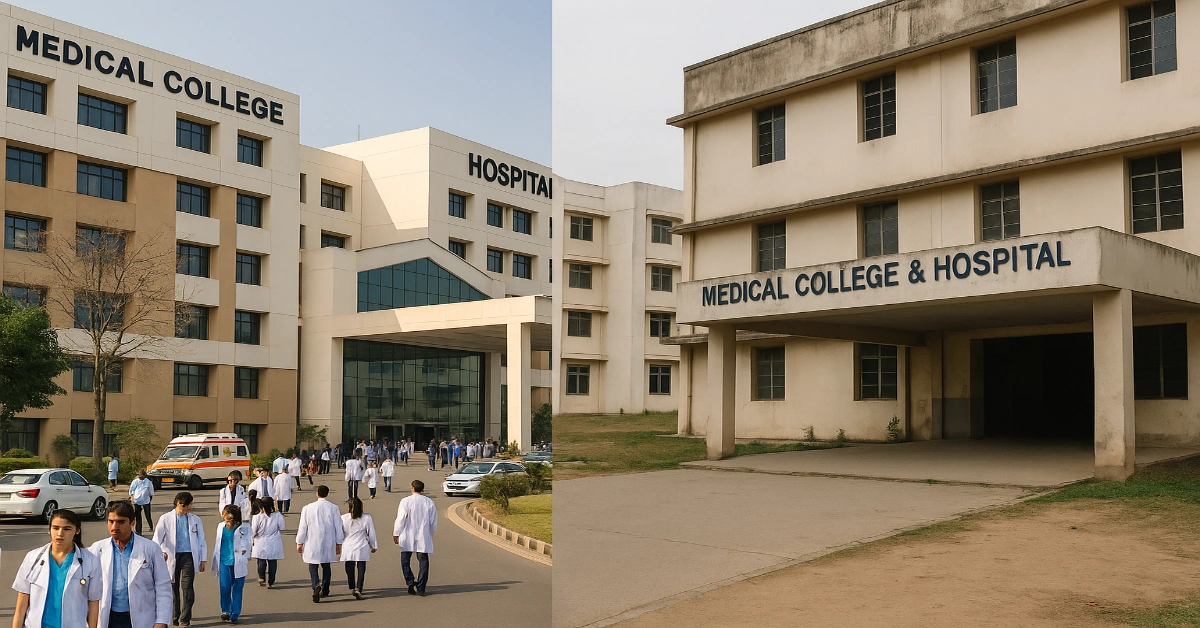Private medical colleges have always been part of discussions around quality, fees, and training in India. When the National Medical Commission (NMC) Bill replaced the old Medical Council of India (MCI), many expected that private medical colleges would improve in both standards and transparency. And they want to assess on how NMC Act 2019 changed private medical colleges.
The NMC aimed to improve transparency, reduce corruption, and standardise the quality of medical education across government and private institutions.
But the big question remains: “Are private medical colleges better now, or do old issues still continue, just in new forms?”
However, the real impact has been a mix of positive steps and ongoing challenges. Let’s understand this in a simple, clear way.
Why the NMC Act 2019 Was Introduced
Before NMC, the Medical Council of India struggled with accusations of corruption, poor monitoring, uneven standards across medical colleges, and slow decision-making. This created huge differences in the quality of medical education across the country.
Under MCI, medical colleges were often criticised for:
- Inspections that could be manipulated
- Ghost faculty (borrowed only on inspection days)
- Poor hospital patient inflow
- No uniform fee structure
- Huge difference in training standards
The NMC Act 2019 aimed to solve these issues by bringing:
- Uniform academic standards
- Digital verification of faculty & patient load
- Better transparency in assessment
Read Also: NMC Just a Rebranded MCI- Lancet Report Slams after CBI Probe
How NMC Act 2019 Changed Private Medical Colleges
Key Changes Introduced by the NMC Act 2019 for Private Medical Colleges
Minimum Standard Requirements (MSR 2023 & 2024)
Private colleges must now meet strict infrastructure rules:
- Specified numbers of lecture halls, labs, libraries
- Simulation labs for clinical skill training
- Minimum hospital beds and OPD patient load
If patient load is low then College risks losing recognition or seats.
Digital Tracking of Faculty
Recently, NMC has mandated FACE-Based Aadhaar attendance and discontinues QR code system to strictly monitor faculties attendence.
This made it much harder for colleges to:
- Hire temporary or fake faculty for inspections
- Use visiting doctors as full-time faculty
Impact: Real faculty presence has improved, but faculty workload has increased in many colleges.
Curriculum Changes (CBME System)
The new Competency-Based Medical Education model focuses on:
- Early clinical exposure
- Practical skills over rote theory
- Communication & ethics training
However, adoption varies:
- Top private universities implemented it smoothly
- Low-fee private colleges still struggle with faculty and resources
Read Also: The Lancet Applauds NMC Reforms and Global Rise of India in Medicine & Medical Education
Fees: More Transparency, But Still Not Uniform
Under NMC fee guidelines, states can regulate fees for 50% seats in private colleges, aligning them with government college fees. This was intended to reduce the financial burden on students.
However, private colleges often increased the fees of the remaining seats to maintain their revenue. So, the overall cost of MBBS in private colleges remains very high, and affordability continues to be a concern for middle-class families.
Hospital Training: Mixed Reality Across Medical Colleges
In some medical colleges, especially those attached to large corporate hospitals or well-established city hospitals with high patient inflow, there has been a noticeable improvement in hands-on clinical training.
Students in such institutions typically get more opportunities to examine patients, assist in procedures, and actively participate in clinical rounds.
However, challenges persist in many other colleges, particularly in newly opened institutions or those located in smaller towns where patient inflow remains low.
Read Also: NQAS Checklist for Medical Colleges: A Turning Point in India’s Medical Education
Due to limited case exposure, clinical skill development is often compromised, and students frequently report that their training is more observational than participatory.
Even though the NMC now audits OPD and IPD patient data to ensure colleges maintain a minimum clinical load, students still commonly express a concern: “We watch more than we do.”
Faculty Quality: The Core Challenge
Despite the introduction of biometric attendance, many medical colleges still struggle with a shortage of experienced senior faculty members. A major reason is the significant salary gap between government medical colleges and private institutions, which makes it difficult for private colleges to attract and retain senior professors.
Read Also: NMC Medical College Faculty Rule 2025: Know Who Will Teach You MBBS!
As a result, teaching responsibilities often fall on younger or relatively inexperienced doctors who may not yet have the depth of clinical exposure needed for effective mentoring.
This also leads to high faculty turnover, disrupting academic continuity and weakening the mentor-student relationship. Ultimately, students receive less structured guidance and reduced support in building clinical confidence.
Also Read: NMC Faculty Rules 2025 Aims to Expand Medical Education in India
How NMC Act 2019 Changed Private Medical Colleges: Better or Worse?
| Aspect | Before NMC | After NMC | Result |
|---|---|---|---|
| Faculty Attendance | Often manipulated | Digitally tracked | Improved |
| Clinical Training | Uneven | Improving slowly, but inconsistently | Mixed |
| Fee Control | Unregulated | Regulated up to 50% seats | Helpful, but partial |
| Infrastructure | Could be shown only during inspections | Must be maintained year-round | More accountability |
| Teaching Quality | Strong variation | Variation still exists | Needs long-term reform |
Conclusion: How NMC Act 2019 & Private Medical Colleges
The NMC reforms did improve transparency and structure, especially in:
- Faculty verification
- Infrastructure standards
- Curriculum modernization
However, the real quality of medical education still depends on:
- Hospital patient load
- Experience and stability of faculty
- Serious implementation at the college level
So the answer is: “Private medical education is improving, but unevenly.“
Students must evaluate colleges carefully before admission, rather than relying on brochures or rankings.


